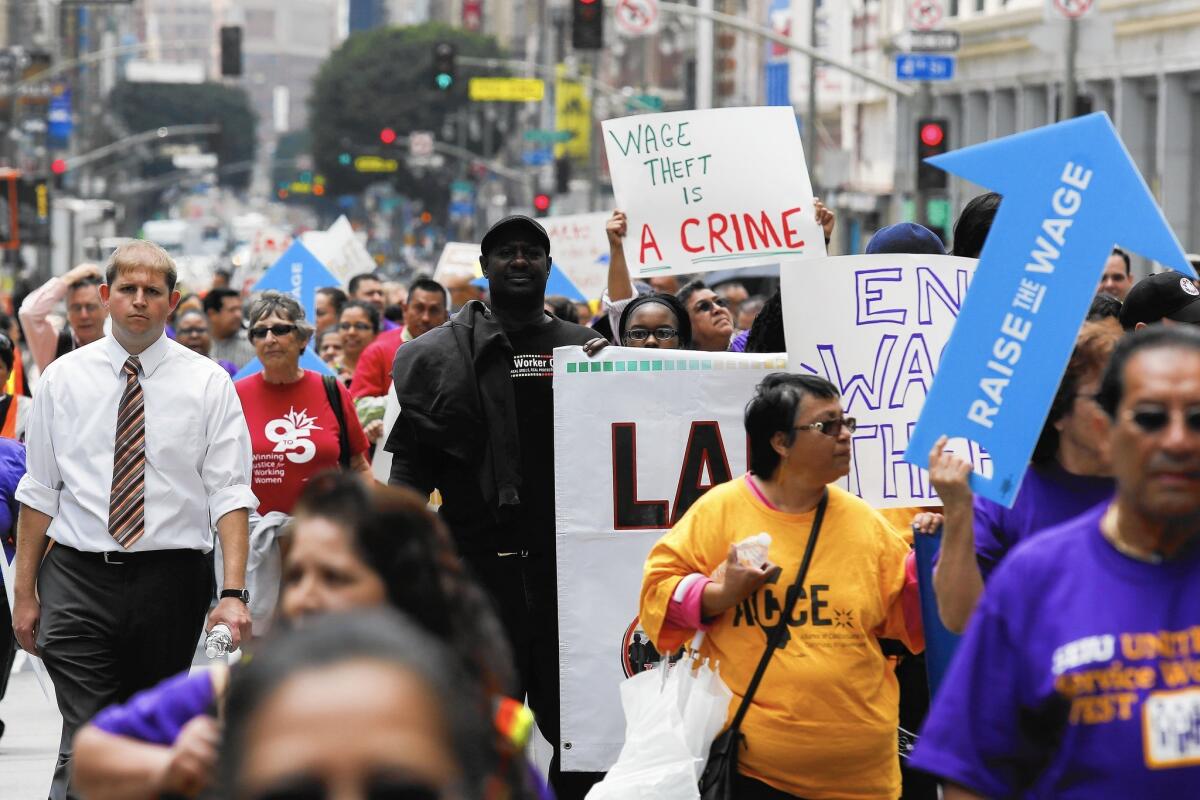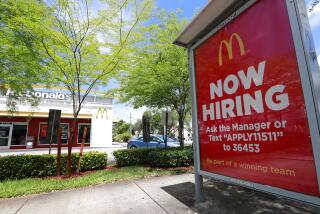Worker salaries are poised to climb in 2016

- Share via
reporting from washington — American workers are poised in 2016 to finally get what they’ve been missing for years: higher salaries.
Even as the recovery from the Great Recession brought booming corporate profits, most workers’ salaries have barely kept up with inflation. But now, as the nation edges ever closer to full employment and with layoffs near historical lows, there are growing indications that ordinary workers are finally starting to reap some of the gains of the 6 1/2 year-old recovery.
A variety of wage and salary statistics — from payroll processors, private analysts and Federal Reserve researchers — indicate that the underlying rate of pay increase for workers has been picking up much more in the last year than commonly thought.
“We’re at a turning point,” said Mark Zandi, chief economist at research firm Moody’s Analytics. “I think it’ll be a breakout year [in 2016] for wage growth.”
If average workers’ pay does rise significantly, it should give a nice boost to consumer spending, the key driver of U.S. economic growth. It should also increase consumption among lower- and middle-income households, providing a more balanced pattern of spending that for years has been skewed to wealthy households.
Economic growth next year is projected to remain moderate, but about half a point stronger than this year’s pace of a little more than 2%.
Moody’s estimated that the average pay for full-time workers who have kept their jobs grew 4.1% in the third quarter from a year earlier. That’s about double the hourly wage increase for all private-sector workers as reported by the Bureau of Labor Statistics, which produces the most commonly cited figures on workers’ earnings.
But the labor bureau’s report is based on aggregate data that include part-time and new workers, so the overall wage changes are likely to understate the gains of many existing workers. Moody’s relies on records of 24 million existing employees from the payroll processor ADP. And they exclude new hires who may be replacing higher-paid baby boomers retiring from their jobs.
A separate study of wages by the Federal Reserve Bank of Atlanta found a similarly improving trend: Median wage and salary growth, after hovering at about a 2% annual pace from 2011 through June 2014, has since risen to more than 3%, according to the Atlanta Fed. The growth was generally stronger for male and full-time workers, as well as those with college degrees. The median marks the halfway point.
It shouldn’t be surprising that wages are creeping higher. The labor market has been tightening across the country, forcing more employers to offer higher pay to recruit and retain workers. Thirteen states had a jobless rate of 4% or less in November, up from five a year earlier.
The jobless rate nationwide was 5% last month. Even big states and cities on the coasts with traditionally higher joblessness have seen sharp declines. California’s unemployment figure fell to 5.7% last month from 7.2% a year earlier.
At 2.3%, Iowa City, Iowa, shares the lowest jobless rate with Lincoln, Neb., and is one of 31 metro areas in the nation with a jobless figure of 3% or less. Things have gotten so tight in Iowa City that the area is sending folks to the Rose Bowl next month — not just to root for the Iowa team, but to recruit employees from Southern California, said DaLayne Williamson, workforce services director at the Iowa City Area Development Group, a nonprofit.
Williamson estimates that pay in her region is now averaging 3% to 5% higher than a year earlier, although it’s considerably more for skilled and technical positions. Openings at a Whirlpool plant in nearby Amana include electrical technicians earning $49,000 a year.
“Larger companies have full-blown campaigns to reach people,” Williamson said.
Competition — and pay — will only rise as the U.S. reaches full employment. Most officials at the Fed, which began raising its benchmark interest rate this month after seven years of keeping it at rock bottom, regard 4.7% as full employment.
A broader measure of unemployment and underemployment, which includes part-time workers who want full-time jobs, stands at a much higher 9.9% of the labor force. But if the economy continues to generate an average of 200,000 jobs or more a month next year, as it has for the last three years, both this broader rate and the official jobless figure are likely to hit optimal levels sometime next year.
The ongoing exodus of baby boomers from the workforce and other shifting demographics may also squeeze employers, and that could give workers more bargaining power.
But Jared Bernstein, the former chief economist to Vice President Joe Biden, is skeptical that ordinary workers will see a big jump in pay next year. Labor’s share of national income has been declining for decades, which he and other experts attribute to various forces: the declining clout of unions; foreign competition and trade imbalance; rapid technology change and automation; and disproportionately large gains to Wall Street and the financial sector.
For now, Bernstein suspects there may be a larger pool of unemployed, available workers than people assume, and this latent supply could weaken wage growth. Many prime-age workers, primarily men and mostly without college degrees, dropped out of the job market in the last decade. Nobody knows for sure how many of them could return to the labor force.
Still, employers will almost certainly find it hard not to pay workers more as the economy heads toward full employment. And there’s no obvious reason, Bernstein said, why the job market can’t continue to churn out 200,000 jobs a month for the foreseeable future.
Moreover, worker wages will get an additional boost from higher minimum wages taking effect in a number of cities and states. California’s new minimum pay goes to $10 an hour in January. The increase will amount to an 11% pay raise for Marco Ruiz, a carwash worker in Anaheim who earns $9 an hour.
That’s an additional $40 a week, more than enough to cover Ruiz’s bus fare to his job from his home in Norwalk, which he rents with his brother-in-law. “It’s marvelous,” said the divorced 35-year-old, who started at the carwash eight years ago making $7.50 an hour, the state’s minimum wage then.
Like Ruiz, most people in the U.S. already feel more secure in their jobs. As layoffs have receded sharply, weekly filings for new jobless benefits have fallen this year to numbers not seen since the early 1970s. And Gallup polls show workers’ “complete satisfaction” with job security rose to a 15-year high in summer 2014. Their overall satisfaction with pay, however, hasn’t returned to prerecession levels. In fact, many workers still feel that the recovery from the Great Recession passed them by.
That’s understandable, said Robert Shapiro, the former Clinton administration economic advisor and chairman of the consulting firm Sonecon. When Shapiro studied changes in household incomes by age groups, from 25 to 60 years old, he found persistent declines from 2002 to 2013. Shapiro said 2014 marked the first substantial upturn in years for households across the board, including those without college degrees. He surmised that was the result of an acceleration of job growth in 2014 to more than 3.1 million, the most in 15 years.
“We had a great year in 2014, and we’re having a good year in 2015,” Shapiro said, referring to the projected 2.5 million jobs created this year.
“We don’t know whether it’s an anomaly or the start of a new trend,” he said. But”I think you’ll have more people feeling better soon.”
MORE BUSINESS COVERAGE
Offering breakfast is a made-to-order success for McDonald’s
How Blizzard turned a costly failure into the highly anticipated ‘Overwatch’
‘Star Wars’ crosses $1 billion in record time, topping ‘Daddy’s Home’ and ‘Joy’
More to Read
Inside the business of entertainment
The Wide Shot brings you news, analysis and insights on everything from streaming wars to production — and what it all means for the future.
You may occasionally receive promotional content from the Los Angeles Times.











